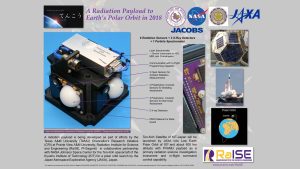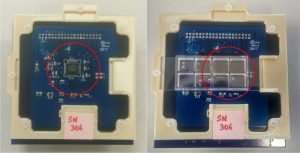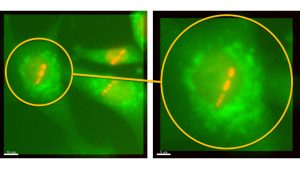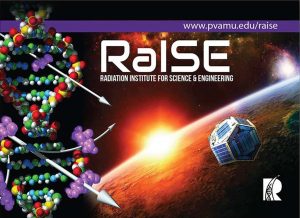Prairie View A&M University’s Radiation Institute for Science Engineering (Raise) has developed and launched two first cosmic radiation measurement payloads.
Recently, we have designed and developed two innovative space radiation payloads with minimum mass (<1 kg) volume (<1 u), minimum power requirements (~1 w), maximum resolution of radiation particle measurements (maximum resolution of pixel resolution (CMO) of complementary metal-oxide semiconductor (CMO) sensors). Both space payloads were built at the NASA Johnson Space Center in the US.

Our first payload – radiation Particle Pixel Detector (PPD) was launched into deep space onboard the Shinnen-2 spacecraft of KIT-Japan that was spun off along with the Hyabusa-2 (asteroid exploration mission) of JAXA – Japan in 2014. Our second payload – Solar and Heliospheric Assessment of Radiation Particles (SHARP) Charged Particle Detector (CPD) was launched into polar orbit onboard Kit-Japan’s Ten-Koh spaceship in 2018 by Jaxa’s H2 rocket – Japan. Both payloads were successfully collected and data was transmitted through the onboard spacecraft’s own radio frequency communication portal. Our first payload received the highest approval and honor from the Japan Science and Engineering Association in 2016, successfully collecting radiation data and sent it from deep spaces mounted on Shinen-2 Spacecraft near Venus’ orbit.
PPD: First deep radiation measurement via radio waves
The first CMOS-based radiation particle detector launched into deep space has been successful and has proven to be promising in several other advancements with five unique features:
The PPD Payload Shinen2 spacecraft was launched on December 3, 2014 as part of Hayabusa2 in an elliptical orbit around the Sun (moving between Mars and Mars orbits across Earth’s orbit) (a second sample return objective asteroid exploration mission). Designed and constructed by Kyushu Institute of Technology (kit-dapan), the shinen2 spacecraft is hexagonal 15 kg, 47 x 49 x 49 cm construction, constructed with lightweight, durable carbon fiber reinforced polymer (CFRP), with dual panels charged on each side mouf. Shinen2 proved success by sending data from the lunar orbit. The only payload of Shinen2 is a radiation detector designed and constructed by Prairie View A&M University (PVAMU), in collaboration with the NASA Johnson Space Center (NASA-JSC), the University of Texas (UT-Austin), the University of Nevada and Las Vegas (UNLV). Radiant particle pixel detector (PPD), 10 x 10 x 10 cm cube structure, unique ability to downlink data to (i) low weight (~800 Gr), (ii) low power (~1 w), (iii) high reliability over several years (~5 years), (IV) (IV) (IV) high tolerance range in deep space hersing environments over a wide range of temperature environments (IV) low bitrate communication transmissions to the Earth (kilobytes less). Our payload PPD uses two CMOS sensors and a custom designed radiation curing field programmable gate array (FPGA) to maintain a deep space radiating environment with the ability to estimate energy and particle flux. This is because 85% of the protons and 14% of the alpha in the galactic cosmic ray (GCR) composition are usually environmentally friendly.
Sharp-CPD: First X-ray measurement using CMOS sensor
Construction and launched on October 29, 2018 as part of the 10 koh spacecraft of Kyushu Institute of Kit Orbit for Jakusa, Japan’s Earth’s polar orbit, the first sharp CPD payload of this kind was in Earth’s polar orbit at 93 degrees of ~600 km by Japan’s polar orbit.

This unique payload consists of six radiation sensors, two x-ray detectors, and one particle spectrometer. This groundbreaking combination of sensors can be best categorized into seven prominent features.
The custom riurin particle spectrometer developed by the Bulgarian Academy of Sciences (BAS) was further designed to collect radiation measurements in conjunction with six other radiation sensors from PVAMU for further dimension comparisons. One set of two radiation sensors is covered with polyethylene spheres to collect data on the effectiveness of the radiation shield. “Another set of two sensors is covered in polystyrene to assess dose measurements over a long period of time. There are two open sensors that collect ambient radiation measurements. The pioneering design of Sharp-CPD Payload also features two sets of sensors integrated with sparkling materials to detect X-rays in polar orbits. The entire frame structure is constructed with 3D printed PEKK material for low static electrical interference that allows for the best possible data collection ever. Finally, this payload boasts command control capabilities in flight, allowing for independent management of the data collection protocols for all sensors.
Click here for live tracking of Ten-Koh Spacecraft from your location and 10-day future forecasts.
Details of Raise-USA’s Shinnen-2 and Ten-Kho.
Details of Kit-Dapan’s Shinnen-2 and Ten-Kho.
Key partners:
•Professor Saganti (USA) – a leading scientist
Professor Holland (USA) – Principal Engineer
•Professor Cucinotta (USA) – Principal Modeling
•Professor Okayama (Japan) – Principal Architect
•Professor Dachev (Bulgaria) – Main Measurements
Radiation Track Structure Detector (TSD): for the highest resolution of the highest microdosimetry and real-time imaging
•CMOS sensor dimensions: 0.644 cm (H) x 0.461 cm (V)
•Total active pixels: 3664(h)x 2748(v)=10,068,672
•Each pixel size: 1.67 µm x 1.67 µm
•Overall unit: 10 cm x 10 cm x 2 cm (sensor board +
Control board) 3D printed holder
Recently, we have developed a CMO (Complementary Metal Oxide)-based spatial radiation track structure detector (TSD) system for capturing and analyzing heavy ion tracks with cell sizes above 10 m pixels at a ~1cm² sensor, 1.67 microns per pixel resolution.



To characterize the heavy ion particle track structure at the micron level, we collected data containing several heavy ions of different energies, including carbon ions in the Brookhaven National Laboratory (BNL)-US NASA spatial radiation chamber (NSRL), as well as carbon ions in the heavy ion medical accelerator at the Kiba (HIMAC) facility. Due to recent extensive interest in particle therapy for various therapeutic applications, we have calibrated track structure detectors for several ions, including helium, carbon, oxygen and iron ions (55 MEV-300 MEV) at NSRL and HIMAC. All experiments using the detector system have been enhanced with biological samples using custom built chamber slide adapters designed to be at the top of the sensor unit to correlate the spatial distribution of track structures with the spatial distribution of orbital impacts at cell sizes.
Data from particle tracking images at Micron resolution using a custom developed CMOS sensor unit is extremely promising for interpreting track length and spatial distribution of radiation at cell size. Our data are also promising to study fragments along particle trajectories. The results of carbon ion tracks and cell impacts are presented along with observations of other heavy ion track structures. These TSDs will be improved for 3D data in cellular dimensions in the near future and can be custom developed for a variety of medical applications, if necessary, for real-time assessment of various terrestrial radiotherapy options and human spatial exploration operations.
Research Support:
USA – Seth Saganti, Sonia Kolli, Mahmudur Rahman, Ramesh Dwyivi, Blaine Kadnik, Gary Erikson, Richard Hagan, Xiaodong Hu, Jordan Lone, Andrew Bateman, Karina Menez, Megumi Hada, Hehen Wang.
Japan – Isai Fajardo, Jesus Gonzalez Lorente, Rafael Rodriguez.
Bulgaria – Pramen Dimitrova, Borislav Tomova, uri matviichuka.
Germany – Shannon Adler contributed and edited this publication.

This article also appears in Space Special Focus Publication.
Source link

